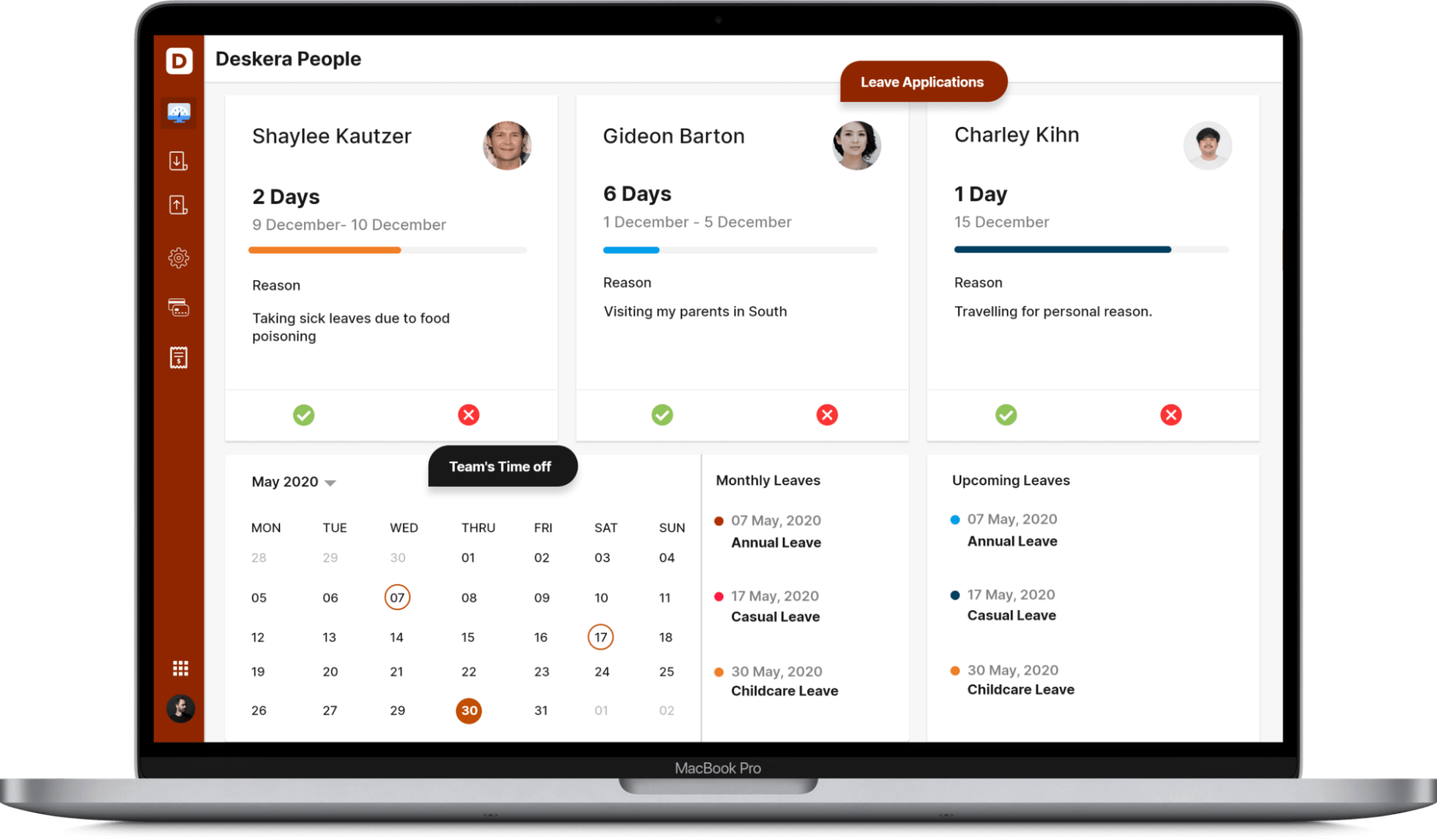Did you know? The absence rate for all full-time wage and salary workers is 2.8%. On average, 2.8% of the workforce is absent from work on regular workdays. We are not saying it; the Bureau of Labour Statistics recently reported so. Indeed, it's not good news for many of you business owners. Is there a way we can help with this?

Good news! There is. Before we get to solving the problem, let us understand the problem. Let us start by learning what is absenteeism and why it is absenteeism increasing at workplaces? Later in the article, we will also learn what you can do to reduce it. Let’s get started!
This article covers the following:
- What is absenteeism?
- What are the types of absenteeism?
- What are the disadvantages of absenteeism?
- What are the causes of absenteeism?
- What are the some tips to reduce absenteeism in workplace?
- How to measure absenteeism?
- How can Deskera assist you?
What is Absenteeism?
Absenteeism happens when an employee begins to miss workdays persistently. Absenteeism is costly to businesses, supervisors, and colleagues and can cost habitual perpetrators their Job.
In any case, while absenteeism is regularly seen as an employee issue, recent reports uncover that it can be a side effect of a lot bigger organization-related issues. Well, we will learn all about absenteeism at the workplace shortly in this article. Let us first look at the types of absenteeism.
What are the Types of Absenteeism?
It is not necessary that every kind of absenteeism is a problem for you as an employer. There are various types of absenteeism that you must be aware of. Once you have identified what type of absenteeism you are facing at your workplace, it will be easy for you to make a plan of action to avoid it. Here is a list of types of absenteeism.
Unauthorized Absences
This is where absenteeism becomes an issue. Unauthorized and disingenuous absences are often the most frustrating scenario for those who are left to pick up the absent employee’s work and manage the absence overall. Examples include participating in a work strike or choosing not to go to work without an approved or genuine reason.
Authorized as well as Planned Absences
This includes any time off that has been arranged between the employee and their superior, such as holiday leave, appointments, personal leave, paternity or maternity leave, compassionate leave, etc.
When an employee has submitted and approved their request for time off, their absence shouldn’t be an issue. With the right preparations from the employee and their team, any work and tasks can be scheduled around their approved absence accordingly.
The Unplanned Yet Genuine Absences
Sometimes, though, needing a half-day, a full day, or multiple days off from work can’t be planned for. While disruptive to the workplace, unplanned, genuine absences are simply a part of life. These include illness, family emergencies, or accidents.
These are the three different types of absenteeism that you may have in your organization. Now let us learn about the disadvantages of absenteeism.
What are the Disadvantages of Absenteeism?
An international survey by SHRM indicates that productivity loss in the U.S. ranges from 22.6% for planned absence to 36.6% for unplanned absence. The productivity loss for the supervisor was 15.7% and included tasks such as the administration of absenteeism, adjusting workflows, and taking over certain tasks. Let us looks at some other disadvantages of absenteeism.
Weak Performance & Productivity at Work
Absenteeism can affect individual productivity. Simply put, if someone works less, they're likely to be less productive. Employers should consider root causes, which include burnout, disengagement, as well as those that may require accommodations, such as child care or illness.
Organizations should address these issues immediately. If an employee is frequently "checked out," it could be a sign of low morale and engagement and a lack of passion for their work.
Impact on Overall Team Performance
As missed work time increases, employees in the office are left making up for the work not performed by employees who are absent. According to the Society for Human Resource Management (SHRM), overtime is used to cover 47 percent of employee absences, and co-workers are perceived to be 29.5 percent less productive when covering for absent employees.
Even supervisor productivity is impacted. According to SHRM, supervisors spend more than four hours per week dealing with absences and preparing for/adjusting workflow to keep things moving.
In other words, one of the biggest negative impacts of absenteeism on the employee experience is the added workload that colleagues must take on for employees who are absent.
Less Profit
Absenteeism can reduce profit margins in the following mentioned two ways. To begin with, increased costs reduce profit margins unless revenues increase. For example, if organizations are spending more money on overtime pay and contract workers, direct costs go up, and profit margins are likely to shrink.
Secondly, absenteeism can decrease revenue if employees with specific roles aren't present. Employees who sell services or build and deliver a product, such as workers in manufacturing, software engineering, consulting, or sales, simply have less time to hit their goals when absent, potentially decreasing revenue.
The impact of absenteeism is felt directly by individuals, teams, and the organization as a whole, putting pressure on productivity and profitability. HR leaders can make a direct impact on organizational performance and employee morale by discovering and addressing the root causes of absenteeism and making strides to address those issues.
What are the causes of Absenteeism?
Workplace Bullying Or Harassment
Workplace bullying and harassment are prominent issues in the UK. In a 2020 survey, 23% of British workers said they’d been bullied at work, and 25% said they’d been made to feel left out.
In the workplace, specifically, bullying and harassment can include denying someone training or promotional opportunities, unfair treatment, spreading rumors, or undermining someone.
Mental Health Issues
Over 11 million workdays are lost due to employee stress, whether that stress is due to dealing with employee burnout or overwork, or due to family, financial, or personal issues. Aside from stress, mental health conditions, including depression, anxiety, or other illnesses, can often lead to an employee feeling unwell enough to miss work.
Commuting Issues
If you’re a commuter, you already know there are countless ways your daily trip to the office can go wrong. Employees can often miss hours of work due to inclement weather, delayed public transportation, construction, car trouble, or accidents.
Team And Management Issues
When an employee doesn’t respect or agree with their management team, becomes bitter after a negative interaction with leadership, or disagrees with their company’s decisions, they may disengage and skip out on work to avoid the situation or related stress.
Major Illness And Long-Term Conditions
When an employee faces a major illness, they’ll typically need an extended period of time off work to recover, along with a clear return-to-work program that eases them back into their role.
When dealing with a long-term medical condition, an employee may need a customized work environment or more flexibility in their schedule to account for routine medical appointments.
Approved Leave
Approved leave falls under the Approved and Planned Absences category and is often much easier to manage. This includes bereavement leave, paternity leave, maternity leave, paid holiday, etc.
Family Issues
While some employers encourage their employees to leave their personal issues at the door, it’s not so easy. Difficult situations and circumstances such as divorce, an urgent matter with a child’s school, a sickness in the family, or lack of childcare support can lead to emergencies that employees must leave work and tend to.
Minor Illness
In the UK, the average rate of absenteeism from work due to illness is 4.4 days per year. While you can’t necessarily control when you get sick, informing your superior as soon as possible can help make your absence easier to manage.
Low Employee Engagement
Employee engagement is a vital part of the 21st-century work culture. Corporations follow the practice to bring employees closer to their workplace in the shorter term. Employees who feel connected to their workplace are more likely to perform better than others who are not. Having low or no employee engagement at work is one of the key reasons behind an employees' unscheduled absences.
Time Theft
Absenteeism doesn't always mean being absent for a whole day or two at the workplace. Employees taking unnecessary long breaks, coming late, and leaving too early also imply absenteeism. This also raises questions about employees' dedication towards their work, leaving a wrong impression about them.
Workplace Burnout
Burnout is one of the major reasons for ill-performance displayed by employees. This mostly occurs when employees are subjected to rigorous and unscheduled working conditions. Most of the time, the issue of workplace burnout goes overlooked.
A good HR practitioner knows how important it is for the employees to find some time for themselves to rejuvenate. However, in most cases, employees are overexposed to work, sparing them no time for themselves. And in the long run, this leads to the degradation of their interest in their workplace.
Substance Abuse
This is something that is widely spoken but less discussed. Often employees succumb to unethical means of rejuvenation. Here, one of the most common examples would be alcoholism.
When they begin practicing substance abuse, employees lose track to let go of their stress. It breaks down the employees physically and mentally by hampering their motor functions and ability to think. Therefore, leaving them with no capacity to perform their duties willfully.
Lack of a Flexible Work Schedule
Flexible working has become a necessity rather than a privilege for professionals across businesses. Employees have their own social and personal commitments that they need to abide by to enjoy a sound work-life balance. In such a case, the lack of a flexible working schedule can cause the employee to miss out on work to follow up on their responsibilities.
Misuse of Seniority
When employees have been a part of the organization for a long time, they get accustomed to its operations. Being senior employees, they often do not feel the need to inform their counterparts about their absence. And this also counts as a mark of absenteeism from work. Therefore, as an employer, you must keep a check on such impromptu leaves.
Low Workplace Morale
No one wants to come into a work environment where conflict is rife. The importance of maintaining good employee morale in your organization cannot be stressed enough. Treating employees with respect and giving them the freedom to make decisions is the backbone of a healthy work environment.
Once this standard has been set, you can explore other ideas such as paid time off, workplace ‘fun days’, or other events to boost morale. Keep the dialogue open and ask for feedback to get more ideas from your team.
Child or Elder Care Issues
Employees who struggle with child or elder care issues may find it difficult to make it to work on time or give advanced notice when they need to take time off. Consider implementing flexible work schedules so these employees can work from home or come in earlier in the morning to make up time and get their work done. Put a system in place where these employees can easily communicate their schedules to HR managers and keep everyone in the loop.
Stress
Stress can lead to a number of problems. Employees under extreme stress due to work or personal reasons get sick more often, may have poor morale, and are more likely to quit without notice.
While you cannot mitigate all of the stress your employees might have, you can put systems in place to help.
Poor working condition
Poor environment or poor working conditions can cause absenteeism due to unusual situations like no health and safety, an unhygienic environment, employees feeling insecure, and that causes less interest in the job. So in such conditions, no one shows his interest.
Low job satisfaction
There are many reasons causes absenteeism in an organization in which poor job satisfaction is one of them. If employees are not satisfied with the working environment and they do not feel either their job is secure or not in such situation employee feel unsatisfied with their jobs in the end results shows that employee takes lake of interest in jobs because they are not sure that their job is permanent.
Insufficient leadership and poor supervision
Due to poor supervision and insufficient leadership, the employee feels insecure in their jobs. Managers play an important role in achieving an organization’s goals. If the leadership is not good and their behavior towards employees is not fair that all, the structure of the organization fails.
If supervisors and leaders are not cooperative with the staff then workers take less interest in their jobs Employees feel fear to go their jobs, and that causes absenteeism.
Personal problems
Personal problems cause absenteeism; those can be martial, financial, child care, substance abuse, etc. everyone has a different in their lifestyle if someone has a financial problem he need some money to solve his domestic problems and the pay he gets from his employee is not sufficient to fulfill one’s domestic needs and wants and some times there may be personal problems and some times there are a lot of problems can be caused by children.
Sometimes people have their martial issues to solve so in such situations man cannot give his availability to an employer these are one the major things that caused the absence of work.
Workload
Within an organization there are different types of methods are used to achieve their tasks. These methods effects employees, every management have their own style to involve their employee in a task and to get impressive performance.
Some times burden of work creates a bad impression which causes low interest in the job. The employee feels a burden on their shoulder and in the end when there becomes a workload on a job he makes excuses to go to the job.
Transportation/Commute Problems
As we have discussed many reasons cause absence of job we can say that transport problem can be one of them. Everyone cannot afford personal conveyance for traveling. Most people use public transport for their routine traveling.
If the transport system is poor then no one can say that man can reach everywhere according to their schedule.
Motivation
It is necessary for managers to consider the importance of motivation because it stimulates employee behavior to achieve organizational goals. In many ways, employee motivation and performance provide the firm’s day-to-day support for competitive advantages.
Motivation sustains our behavior keeps it systematic and assembles and concentrates our attention to achieve goals we value, managers who ignore established principles of motivation will foul up their operations because they will fail at the crucial task of linking the firm’s goals to the behavior of their employee.
Change
A changing work environment, caused by a merger or acquisition, poor economic climate or unforeseen circumstances, can make employees feel insecure and stressed, which can lead to absence.
The 11 September terrorist attack in America has made the airline industry more vulnerable to this than ever. Following the tragedy, EasyJet had to maintain morale in the workplace by communicating well with its staff.
Alcoholism
The habit of alcoholism is very common among workers. They want to forget their domestic worries by drinking alcohol. Drinking becomes their habit and its hangover the next day compels them to be absent from work. Workers indulge in more drinking after getting their wages and more absenteeism is reported these days.
Inadequate Leave Facilities
The workers do not get proper facilities for attending to family work. Since they are entitled to a limited number of leaves, they do not go to work whenever they have to attend to family needs.
These are some of the major causes of absenteeism that you must be facing in your organization too. How to reduce the rate of absenteeism at workplaces then? If you are wondering the same then worry not because in the next section we will share a few tips on how to reduce absenteeism.
Tips to Reduce Workplace Absenteeism
A renowned business leader Douglas Conant has said ‘To win in the marketplace you must first win in the workplace.’
More Employee Engagement
A good way to make your staff more committed and actually want to come to work is to increase their engagement. This means maintaining an efficient internal communication system where employees can follow what is going on in the company, suggest improvements, report problems, etc.
It also includes investing in employee training and development programs. That way, workers can improve their skills and participate more and more in the organization’s activities.
Provide support
If an employee is absent due to personal issues, like bereavement or mental health problems, you should provide support both when they are absent and on their return to work. Support will likely make them feel happier to return to work earlier and prevent repeated absenteeism.
You could also consider offering your employees time off in lieu and/or flexible working time. This will ensure people feel like they get a good work-life balance and that you value their needs.
Reduce workplace stress
You should always try to rectify factors at work that may cause stress for your employees. For example, if a piece of equipment is broken and employees are stressed, you should aim to fix it as soon as possible.
You should also implement programs that encourage employee health and wellbeing. This should have your employees’ physical and mental health at the forefront and will prove to your workforce that you value both their work and their health.
Reward good attendance
You need to plan this one carefully, as there may be genuine reasons why somebody is absent, such as long-term sickness. However, you should aim to provide a reward for employees who display good attendance throughout the year. This will encourage all to attend and show employees who are always at work that you value them.
Provide feedback
You should provide your employees with frequent and effective feedback, especially when they’ve done something well. If you never provide feedback, your workforce may feel that you don’t appreciate their hard efforts and you therefore won’t notice when they’re not at work.
Create a clear attendance policy
Your workers should know exactly what is expected of them in terms of attendance. Your policy should therefore state how employees are to report absences, how your company will follow up on unsanctioned absences, as well as what the consequences are for excessive absenteeism. Moreover, in order for your policy to be taken seriously, you must enforce it consistently.
Set Rewards for Good Attendance
Implementing a reward scheme for employees with good attendance records is a great way to give them an additional incentive to attend work. But be careful with this one and remember that there can be perfectly legitimate reasons for being absent, such as illnesses. Therefore, the reward system shouldn’t penalize the employees who have excused absences.
Discuss the Non-Sanctional Absences
You should deal with absenteeism according to your attendance policy and be consistent when handing out consequences. However, addressing unscheduled absences isn’t only about dishing out sanctions. You should also be understanding and provide support to your employees. Try to find out the reason behind their absences, they might have a problem that you can help them with.
In that regard, a good practice to introduce is the return-to-work interview. This helps the worker ease back into their role, shows that the company cares about its staff, and reduces the risk of repeated absenteeism.
Work on Employee Wellbeing
Absenteeism is often linked to a stressful or unhealthy work environment. You can then look at ways to reduce stress in the workplace, for instance by implementing a wellness program or taking the appropriate measures to fight harassment.
Make looking after your employees’ health one of your top priorities. Physical and mental health are essential to an engaged and productive workforce.
Flexible Options
Offering flexible working hours is an excellent idea to increase your employees’ well-being and their attachment to the organization. You should therefore consider introducing flexible schedules and remote work. Some companies even offer unlimited vacation days.
Track Employee Absences
Finally, use absence management tools to track employee work time and absences. They allow you to get useful data and measure employee absenteeism. With time, you will be able to check if you were successful in reducing employee absenteeism and make appropriate changes to your policy.
A Culture of Teamwork and Togetherness
Following up on the previous idea, employees are more engaged when they feel that they are part of a team. A sense of belonging increases a worker’s motivation to go to work and their loyalty toward the company.
This will also make them think twice before taking an unplanned day off and make things more difficult for their team.
Scheduling and Planning
Proactive allocation of resources to project tasks gives them enough leeway to plan their schedules in advance. For example, if they are forewarned that they have a high-priority project in the near future to work on, they will plan their work and leave in advance.
This is a win-win for both employers and employees. Neither the project’s progress and quality suffer nor are the resources caught off-guard at the eleventh hour.
Another important factor to consider while scheduling resources to project tasks in their areas of interest. If employees are working on tasks of their preference, it will keep them engaged and motivated, in turn giving their 100% to the job.
Managers can equip a modern resource scheduling tool to plan the resource schedules in advance and get a unified view of their core competencies and roles.
Systematic Work Distribution
As mentioned earlier, over-utilization that results in burnout is one of the major contributors to absenteeism. To combat this, managers must ascertain that every resource is uniformly allocated and no one is overworked. When employees’ schedules align with their availability and standard hours, they will not experience workplace fatigue and distress.
An intuitive resource scheduling tool provides a birds-ey view of every resource, their present and future availability, and foresight into utilization and other metrics. Managers can leverage these features to their benefit and ensure that the workforce is optimally utilized across the organization.
Make Your Purpose & Goals Clear To Your Employees and Motivate Them
Convey your goals to give a sense of purpose
Imagine a situation where you are given the assignment to complete within a certain period without being informed about its purpose. Would you want to take it forward? Certainly not. The same goes for your workforce. They will not be driven to work and execute their tasks if they don’t know how it is adding value.
The onus is therefore on managers to convey the company’s short-term and long-term goals with utmost clarity. The set goals and milestones give an inspirational purpose to employees to stay productive at work. They will work with all their might to execute a quality product and meet the stakeholders’ expectations.
Return to Work Interview
Even a day or two off can offset an employee returning to work. A lot may change during that time. Introducing a program akin to the onboarding process eases them back into their role.
This return-to-work interview may reduce absenteeism:
- Show the company cares for their well-being by checking on them
- Understand the reason for the absence and discuss details of a fit note
- Explain how they can improve and potential disciplinary actions
- Make the necessary arrangements as they return to work
- One could use absence management tools to automate these processes.
- Make the necessary arrangements as they return to work
- One could use absence management tools to automate these processes.
Provide Paid Leaves
These days, employees expect companies to help them maintain a healthy work-life balance. This includes receiving ample paid time off (PTO).
Many companies today offer unlimited paid leave. It lets employees take time off when needed and reduces the harmful effects of presenteeism.
All of this contributes to employees feeling more engaged and loyal to the workplace, which boosts productivity.
Reasonable PTO policies empower employees by transparently showing them how many leaves are available. As a result, they’re more likely to follow the proper procedures outlined in your absenteeism policy and inform you about time off in advance.
Check-In Regularly
Chronic absenteeism without a justified reason can be cause for concern. Checking in regularly with employees at all levels can help you understand their state of mind. It can also allow you to offer flexible work schedules or a reduced workload for a specific period.
You can use these check-ins to gauge employee satisfaction levels and determine whether you need to change any work policies.
Keep The Special Circumstances of Absenteeism in Mind
If an employee is dealing with mental health problems, trauma, or workplace bullying, these may be impacting multiple spheres in their lives.
US employers, especially, can implement an EAP (Employee Assistance Program) to address common employee well-being concerns, such as:
- Finding childcare or elder care services.
- Adoption assistance.
- Legal and financial issues.
- Marital or family problems.
- Mental health counseling.
- Workplace conflicts.
Introduce an Employee Wellness Program
A Towers Watson survey of about 900 employers in North America, Latin America, Europe, and Asia found that organizations with wellness initiatives experienced fewer unplanned absences -- just 3.3 days, as opposed to four.
A wellness program can help you mitigate health-related absences, while simultaneously lowering health care costs and reducing employee stress. Additionally, a wellness program can help improve morale and workplace culture and even increase productivity.
In 2018, 80% of workers report feeling stressed on the job, and nearly half say they need help in learning how to manage that stress. Prolonged stress can lead to health issues including heart disease, obesity, and depression.
By taking steps to create a workplace culture that prioritizes health and wellness, you're able to decrease unhealthy habits that lead to employee absenteeism. For instance, if an employee is able to mitigate stress during your office's lunchtime yoga, she might be less likely to let that stress build-up and lead to bigger problems down the road.
Good Communication With Your Employees
Good old communication. It seems to be the cure to almost every work-based and private-life problem but trust us on this one. Just think, if you were feeling unhappy about something at work that you couldn’t talk to anyone about, might you not be tempted not to come in if you were feeling a little under the weather?
It might be something as simple as having an overly complex complaints procedure, or a two-week turnaround time for responding to emails.
It might be that managers never have the time to speak to employees or haven’t been trained to look out for the warning signs of employees who need to get something off their chest. Improving your workplace communication can go a long way to dealing with, and preventing, absenteeism.
Online GP Services
We’ve mentioned that being able to nip health problems in the bud is important, and as an employer, you are in a position to help your employees as they spend the working day in your office.
Online and video GP appointments are an excellent perk that shows you care about your employees. It means that they don’t have to take as much time off traipsing across town to a GP surgery, and the speed with which appointments can be made means that the issue is likely to be sorted out early. Hopefully, there won’t ever be the need for employees to take any time off at all.
These are some of the best ways for you to reduce absenteeism at the workplace. Find out how to calculate absenteeism in the next section.
How to Measure Absenteeism?
The formula for measuring absenteeism is relatively easy: simply take the number of unexcused absences in a given period of time, divide it by the total period, and multiply the result by 100 to get the percentage of absenteeism over a month, a year, etc.
Formula to Calculate Absenteeism:
Absenteeism Rate = (Average # of Employees X Missed Workdays) / (Average # of Employees X Total Workdays)
1. If you hired or terminated employees during the period, you need to find your average number of employees. You can find the average by adding together the number of employees you had at the beginning and end of the period and dividing the sum by two.
2. Next, you must calculate the number of total workdays during the period.
3. Now, determine how many workdays employees missed due to absenteeism. Although it’s easiest to calculate missed workdays by using full shifts, you can also calculate partially missed days by dividing the number of hours missed by total workday hours.
4. Now that you know how to calculate each part of the equation, plug your numbers into the formula.
There’s no fixed number or percentage that can tell you how much absenteeism is too much; zero is ideal, but some absenteeism is guaranteed in an organization of more than a few people.
How Can Deskera Assist You?
Leave and attendance management is a key function in any organization. With Deskera software you can now make it easy to manage as well. Deskera helps you create custom leave policies and up-to-date, relevant data regarding your requests and applications all on one screen. And many more useful features. Explore more with 15 day's free trial of Deskera software.

Key Takeaways
- Absenteeism happens when an employee begins to persistently miss workdays.
- Unauthorized and disingenuous absences are often the most frustrating scenario for those who are left to pick up the absent employee’s work and manage the absence overall.
- Authorized absence is included any time off that has been arranged between the employee and their superior, such as holiday leave, appointments, personal leave, paternity or maternity leave, compassionate leave, etc.
- Sometimes, though, needing a half-day, a full day, or multiple days off from work can’t be planned for. While disruptive to the workplace, unplanned, genuine absences are simply a part of life.
- Absenteeism can affect individual productivity.
- As missed work time increases, employees in the office are left making up for the work not performed by employees who are absent.
- Absenteeism can reduce profit margins in the following mentioned two ways. To begin with, increased costs reduce profit margins unless revenues increase.
- Absenteeism can decrease revenue if employees with specific roles aren't present.
- Workplace bullying and harassment are prominent issues in the UK.
- Over 11 million workdays are lost due to employee stress, whether that stress is due to dealing with employee burnout or overwork, or due to family, financial, or personal issues.
- Deskera helps you create custom leave policies and up-to-date, relevant data regarding your requests and applications all on one screen.
Related Articles:














